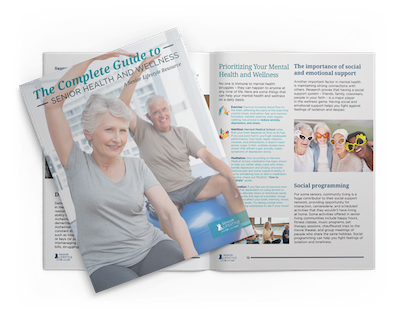Mealtimes in retirement communities are one of the most important activities of the day because they allow seniors to socialize and get their proper nutrients. To ensure a healthy diet, retirement communities must provide well-balanced meals that cater to their residents. This list of foods should include a variety of fruits, vegetables, whole grains, and lean proteins.
In this article, we take a closer look at the top 5 nutritional benefits of retirement community living, as well as key vitamins and minerals required for older adults.
Why Is Nutrition Important For Older Adults?
Good nutrition is essential at any age. However, seniors are at a much higher risk for life-threatening conditions and diseases. Poor nutrition can lead to weight loss, depression, and immune system deficiencies–making older adults more prone to illnesses like the common cold. According to the National Resource Center on Nutrition & Aging, more than 5.5 million seniors are food insecure or malnourished. If there is a lack of meals or poor food choices being made, the well being of you or your loved one could be in danger.
Common Challenges to Proper Nutrition
Getting the right amount of nutrients is important for people of all ages. But for some seniors, this can be a challenge. Important tasks like grocery shopping, cooking, and cleaning can be a common struggle for seniors that prevents them from proper dieting and nutrition.
Retirement communities take the hassle out of healthy eating by providing residents with fresh meals served in a restaurant-style setting. Most communities offer chef-prepared meals for breakfast, lunch and dinner, ensuring older adults are able to receive the proper nutrition they need. Another benefit is the social connection residents receive while enjoying meals in the shared dining hall. Additionally, families and loved ones are more than welcome to visit loved ones to enjoy meals together as well.
Suggested Nutrients For Seniors
Here is the suggested number of daily nutrients, based on the standard 2,000 calorie diet. Please note that your calorie intake may be different, depending on your age, activity level and weight.

Retirement communities understand the troubles faced by seniors when it comes to their health and nutrition. Here are a few ways living in a retirement community can help older adults on their path to a healthier lifestyle.
1. Improves Mood
Eating nutritious foods that are high in carbohydrates can decrease stress levels in your body. In 2016, studies from the Missouri State Medical Association found that a low-carb diet may cause symptoms of depression, sadness, and fatigue. Beyond mood and well being, researchers still have a lot to learn about the effects of food on our mental health. While we still have much to uncover, you can still make some positive changes to improve your eating habits.
- Get at least 15-30 minutes of regular exercise.
- Drink plenty of water to stay hydrated throughout the day.
- Choose less processed sugars and more whole grains at mealtimes.
- Volunteer, join a club, or take part in other communal activities to keep the mind active and strong.
2. Strengthens Memory
With a hearty meal plan from a retirement community, you can strengthen your mental health and wellness on a daily basis. Foods that are packed with vitamins B-6, B-12, niacin (B-3), and folic acid are known to help reduce homocysteine levels in the body. Eating green vegetables, unprocessed cereals, and omega-3 fatty acids also support the fight against memory disorders like dementia and Alzheimer’s disease.

Download The Complete Guide to Health & Wellness for Seniors
As people grow older, their health and wellness needs change. Read our eBook, “The Complete Guide to Health & Wellness for Seniors” for everything you need to know about staying healthy and happy as we age.
Download the Guide
3. Promotes a Healthy Immune System
A healthy immune system protects our bodies against bacteria, viruses, and other invaders. But a poor diet can lead to many health defects, including inflammation. To maintain a strong immune system, seniors will need to eat a balanced diet from each food group. This may include fruits, vegetables, and foods that are low in fats.
4. Manages Weight Control & Metabolism
Diets that contain a colorful variety of healthy foods will help you control your body weight. Studies show that unhealthy food choices contribute to more than 678,000 deaths each year in the U.S. These fatalities are caused by nutrition and obesity-related diseases, such as heart disease, cancer, diabetes, and high blood pressure.
Retirement communities provide meals that are low in saturated fats, followed by moderate amounts of unsaturated fat, promoting a stable body mass index (BMI) and metabolism. In addition, adequate portion sizes also support a healthy weight for older adults because it prevents excessive calorie intake.
5. Reduces The Effects of Aging
Many retirement communities work hard to incorporate foods like tomatoes, berries, avocados, and nuts into their meal plans, all containing vitamins and minerals that are good for the skin. For example, citrus fruits or juices have a high source of vitamin C, which helps to build collagen and reduce premature signs of aging. Researchers suggest that you eat foods with lots of antioxidants to support healthy skin cells as you age.
Retirement communities can help seniors reduce the risk of deadly health conditions, improve mood, and strengthen mental health–all while giving the body its day-to-day nutrients. If you or a loved one are unsure about following proper eating habits, reach out to your care provider or retirement community to discuss further options.

